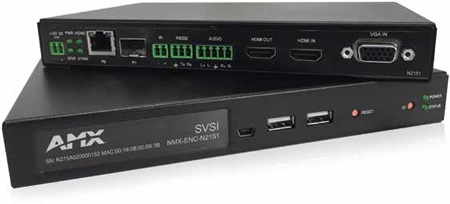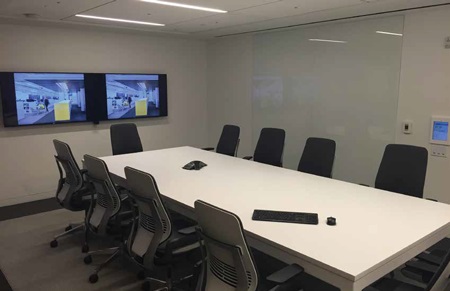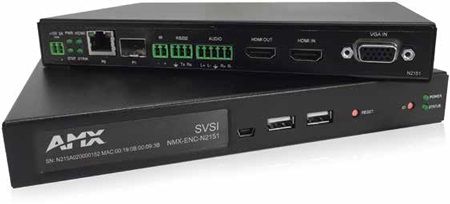Just days before the 2016 CES consumer gearfest got underway in Las Vegas, the 35 member companies of the UHD Alliance unveiled specifications for ultra high definition—UHD, or 4K—devices, distribution, and content. There is no shortage of compliant 4K displays, disc players, and DVRs coming through the consumer retail channel now, but professional integrators have yet to see a broad uptake of the technology.

AMX offers an AV over IP solution with its JPEG 2000 4K UHD Video over IP Encoder with KVM. “It’s important that we recognize that not everybody needs 4K today,” cautioned Danny Barr, vice president, new product business development for ZeeVee. That said, “All of the market studies suggest that the adoption of 4K is probably going to be twice as fast as the adoption of 1080p. The highest selling product on Amazon on Black Friday was a 55-inch 4K display. People are buying 4K—but using it predominantly for 1080p.”
Scott McGarrigle, president and CTO at Utelogy, noted that the higher education market, a focus for the company, is still moving into HD. “There are a lot of schools that are still not digital; they’re VGA and older systems. As they revamp their infrastructures for digital they’re asking what they can do so that they’re ready for 4K. But I don’t see a bunch of people wanting to jump into 4K,” he reported.
The ongoing convergence of IP and IT has enabled certain market segments to adopt 4K technology and infrastructures relatively quickly. Offering four times the pixel count of 1080p displays, 4K has obvious applications in the government, military, oil and gas, medical, and other sectors for data visualization, operations centers, command and control centers, and training.

ZeeVee’s ZyPer4K switcher is an easy to set up solution for 4K distribution. Early consumer adoption is perhaps optimistic, with content still relatively hard to find. Amazon, Netflix, Roku, Sony, and other over-the-top IP streamers are showing the odd title and have promised more soon. But according to Colin Farquhar, CEO of Scotland-based Exterity, which is heavily involved in the redistribution of broadcast content, “We’re only just seeing traditional broadcasters begin to deliver 4K capabilities.”
There are challenges with 4K in other environments, too, commented Bob Sharp, director of international sales, SVSi. “If you look at a 4K display in a conference room, even if you’ve got an Apple Mac that outputs 4K, nobody can read any of the icons or the text. You’re physically incapable of seeing the mouse from the conference room table.”
There is an even larger issue, according to Sharp. “The challenge is what kind of hardware you need to successfully play a high-bitrate 4K file regardless of how you’re going to deliver it. We’ve tried every one of the little boxes that say they are 4K capable. They fail to play any of the 4K files that we have. So we end up using a $600 i5 computer to play a 4K file. That limits the practicality.”
Having quickly found a home in digital signage and wayfinding applications, 4K is now being adopted in high-end retail. “The advertisers and the branders love 4K because it makes their products look better. They are in control of the content and can justify an expensive player or PC just to play that content to the displays,” said Sharp.

According to Scott McGarrigle, president and CTO of Utelogy, what attracts people to AV over IP solutions is the ability to share and collaborate differently, where content isn’t limited to a room. Farquhar agrees that decoding content is an issue. “4K with H.265 is new,” he said. “Getting the content in is relatively easy, but if you want to deliver it to 500 PCs in your office or 100 screens around the building, it’s much more of a challenge.”
In large-scale sports and entertainment deployments, Farquhar added, “They have hundreds if not thousands of displays. The sheer cost of hanging, cabling, and powering a thousand displays becomes more of a logistical issue.”
With these issues in mind, the market is very much in transition, continued Farquhar. “We’re seeing a real interest in transcode products, allowing the easy migration for the end-user from an SD/HD world to a 4K world, perhaps bringing the content in at 4K then delivering it around the facility as HD. The next stage is transitioning display and computing equipment to accommodate the decode requirements for 4K.”
As the transition to AV over IP and 4K picks up momentum, future-proofing is top-of-mind for many end-users. “Why would I not spend a few extra bucks and put in 4K displays?” said Sharp. “If you’re looking at new construction, my opinion is that by this time next year, anything 55 inches and above will be a 4K display. Manufacturers are not going to make large 1080p displays alongside large 4K displays because it’s not viable economically.”
“Knowing that you can handle 4K in the future is great, but clients are willing to pay only a certain amount for that eventuality,” ZeeVee’s Barr commented, whose company has added a product supporting 10-gig 4K over copper to its 4K fiber products. “In many cases people will just choose a 1080p product—which puts us up against HDbaseT products today.”
Utelogy, a software-only control and management system, offers future-proofing and flexibility, said McGarrigle. “Customers are afraid to get locked into a particular design. If you need to add a source or display, it’s just another network node.”
With AV over IP infrastructures, McGarrigle continued, “It’s not a monolithic system anymore. So when it is time to upgrade you can selectively do it. Worse case, you replace an HD encoder/decoder and replace it with a 4K encoder/decoder. Go into Utelogy, add that to the system, and you’re up and running.”
The IP network is a compelling architecture, said McGarrigle. “What attracts people to AV over IP solutions is the ability to share and collaborate differently. Content isn’t limited to a room; I can potentially send that signal elsewhere, to a lecture capture device, a content distribution server, or an overflow classroom—or usurp them and broadcast an emergency message.”
The 4K ecosystem offers more than a higher pixel count, also encompassing high dynamic range (HDR), higher frame rates, wider color gamut, higher peak brightness, and immersive audio. Those features, when enabled and utilized by the content, add to the data. “There’s a cost,” said Farquhar. “When HDR is available, the display will consume twice as much power to process the data.”
The adoption of 10 Gigabit networks in the enterprise has been a catalyst for the IT/IP convergence. While that allows AV over IP integrators to use off-the-shelf switches to move around uncompressed video, “That’s great until you price a 10-gig switch,” argued Sharp. “Our products are compressed 4K JPEG 2000. That allows you to do it over a standard one-gig network. It makes the infrastructure very affordable.”
Plus, said Sharp, “We’re getting pushback for 100, 200 Mb 1080p streams. I can’t imagine the pushback we’d get if we wanted to push 10-gig streams across the network.” AV integrators have to adapt to this brave new world of convergence. “Our traditional audiovisual partners are becoming aware that in many cases, they are not able to sell the complete solution if they don’t have that IT skillset,” said Barr. “Being able to work alongside and integrate with other providers is very important. Those who adapt and provide those capabilities will survive and flourish. Those who don’t will struggle.”
Steve Harvey (sharvey.prosound@gmail.com) has been west coast editor for Pro Sound News since 2000 and also contributes to TV Technology, Pro Audio Review, and other NewBay titles. He has over 30 years of hands-on experience with a wide range of audio production technologies.
